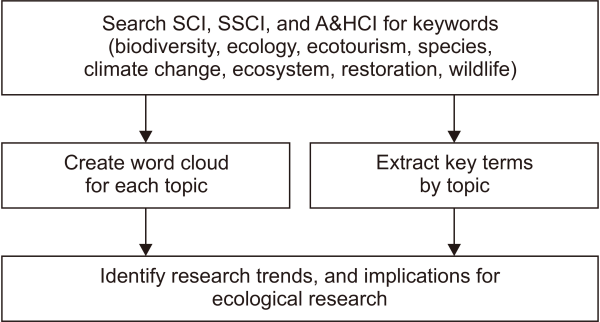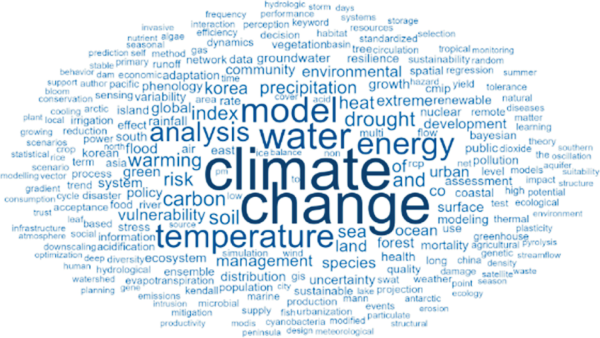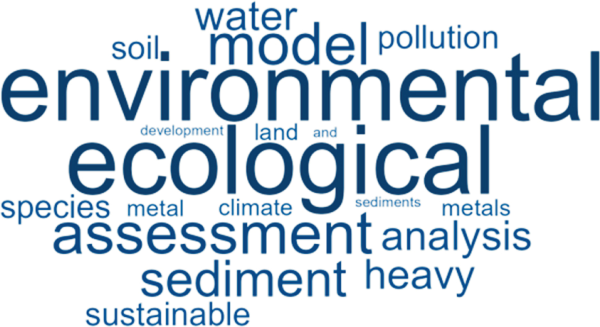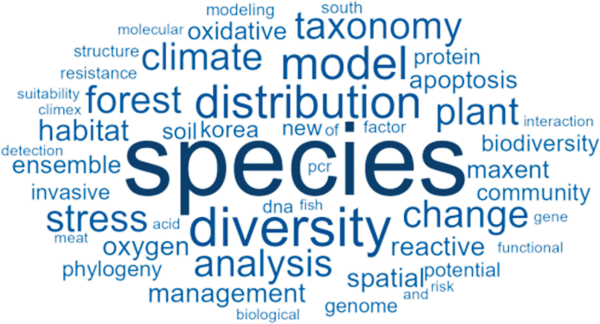Introduction
Ecosystem changes are intensifying worldwide owing to climate change and environmental disturbances. This has led to an increase in large-scale disasters (e.g., a rapid decrease in insect diversity and forest devastation). To maintain the health of ecosystems, and to prepare for and adapt to the new environment, it is necessary to accurately analyze and predict the response of ecosystems to environmental changes. However, because changes in the environment and ecosystems of the Earth occur over a long period of time, it is difficult to accurately analyze the change direction through fragmentary ecological surveys. Accordingly, major developed countries have been continuously conducting long-term ecological research, and the accumulated data are used as an important scientific basis for environmental policymaking (Jin, 2018). Ecological research trend analysis can reveal changes in topics of interest, facilitating the selection of research directions for individual researchers and national bodies. The purpose of this study was to provide basic data for in-depth trend analysis by analyzing research trends in the field of ecological research.
The field of ecology is broad-based and includes research on ecological habitats, reproduction of specific species, survival probabilities of specific species, and the preservation and reuse of data. For example, Jeong et al. (2022) conducted a study to identify bird diversity and environmental correlates within the mulchat-oream wetlands of Jeju Island, South Korea. Kim et al. (2020) conducted a study of metadata design for ecological research data management. Park et al. (2022) estimated occupation probability to predict the potential habitat of an endangered species, the jockey gizzard. Chae et al. (2022) conducted a study on Korean and worldwide research trends on rare and endemic plants in Korea. Lee et al. (2022) conducted a study on research trends in the Baekdudaegan Mountains using big data analyses of academic journals. Mazzotti et al. (2022) conducted a study on the natural and anthropogenic factors influencing nesting ecology of the American Crocodile in Florida, United States. However, studies considering global and domestic research trends in the field of ecological research remain scare. Therefore, this study is of great significance for providing research trend information to support strategic research planning by individuals, research groups, and funding bodies.
Materials and Methods
Research design
Fig. 1 shows the research procedure conducted in this study. The first step was to determine a list of keywords, which was compiled based on recommendations from experts. The second step was to collect metadata pertaining to papers containing those keywords from the Web of Science database. The third step was to analyze the collected data to create a word cloud and analyze the topic map. The final step was to identify the main research trends in ecological research, and the implications for strategic planning.
The major keywords recommended by the experts were: biodiversity, ecology, ecotourism, species, climate change, ecosystem, restoration, wildlife. For each, we searched the SCI, SSCI, and A&HCI databases provided by the Web of Science. The study period was from January 2002 to September 2022. For each keyword, a word cloud was created based on the database papers identified. Next, topic map analysis was conducted using the abstract data from each paper; 10 topics were identified from the papers related to each keyword. For each topic, six key terms were identified.
Results
The main tags in the word cloud created using the biodiversity keyword (Fig. 2) are forest, urban, ecosystem, change, and carbon; among these, ecosystem is at the center. The main tags in the word cloud created using the climate change keyword (Fig. 3) are model, water, temperature, and energy; among these, climate change is at the center. The main tags in the word cloud created using the ecological keyword (Fig. 4) are environmental, model, assessment, and sediment; among these, environmental is at the center. The main tags in the word cloud created using the ecosystem keyword (Fig. 5) are denoising, restoration, image, and water; among these, restoration is at the center. The main tags in the word cloud created using the ecotourism keyword (Fig. 6) are community, development, and tourism; among these, tourism is at the center. The main tags in the word cloud created using the restoration keyword (Fig. 7) are species, conservation, climate, biodiversity, ecosystem, diversity, and species; among these, species is at the center. The main tags in the word cloud created using the species keyword (Fig. 8) are forest, distribution, plant, diversity, stress, change, and species; among these, species is at the center.
Table 1 shows the number of extracted papers by keyword recommended by experts. Next, from the papers identified for each keyword, 10 topics were extracted (Tables 2Table 3Table 4Table 5Table 6Table 7Table 8-9). For each topic, 6 major key terms were identified. Fig. 9 shows an example topic map created using the biodiversity keyword.
Discussion
In this study, the results of the analysis of word clouds and topic maps in the field of ecological research were derived. The results of this study provided a basis for analyzing research trends over recent decades. Moreover, they offer a resource for strategic research planning by individuals, research groups, and funding institutions. In future studies, it will be necessary to review the topics and terms extracted in this study. After that, it is possible to analyze trends in the field of ecological research more accurately by expanding the keywords used for search for each topic selected by experts to re-collect data and conduct re-analysis. In addition, word cloud and topic map analysis can be classified by a specific period to analyze changes in trends. Finally, the expected effects of this study are as follows. The results of this study are expected to be used to select research fields that should be intensively fostered by institutions that support research funds in the ecological research field and to set the direction for fostering ecological research in the country.
References
(2018, Retrieved Dec 21, 2022) The necessity of long-term ecological research from https://seedus.net/nie_multimedia/research_01.html
Figures and Tables
Table 1
Keywords and numbers of papers
| Keyword | Number of papers | Keyword | Number of papers |
|---|---|---|---|
| Biodiversity | 348 | Climate change | 1,330 |
| Ecological | 219 | Ecosystem | 556 |
| Ecotourism | 36 | Restoration | 389 |
| Species | 734 | Wildlife | 34 |
Table 2
Topics and associated key terms related to the biodiversity keyword
| Topic | Number of papers | Term |
|---|---|---|
| 1 | 18 | Concentration, R, canopy, structure, phytoplankton, chlorophyll |
| 2 | 20 | Soil, plant, vegetation, type, content, control |
| 3 | 25 | Biodiversity, diversity, restoration, wetland, conservation, assessment |
| 4 | 26 | Flux, vegetation, scale, information, surface, day |
| 5 | 21 | Forest, land, level, environment, policy, sustainability |
| 6 | 17 | Ecosystem, carbon, production, respiration, productivity, air |
| 7 | 20 | Impact, distribution, fish, population, range, marine |
| 8 | 15 | Rice, biomass, stock, season, paddy, treatment |
| 9 | 31 | Quality, research, landscape, value, method, survey |
| 10 | 23 | Water, climate, temperature, increase, sea, drought |
Table 3
Topics and associated key terms related to the climate change key phrase
| Topic | Number of papers | Term |
|---|---|---|
| 1 | 95 | Concentration, plant, biomass, control, phytoplankton, productivity |
| 2 | 98 | Health, mortality, year, trend, maximum, number |
| 3 | 88 | Stress, flood, damage, frequency, salinity, marine |
| 4 | 78 | Policy, value, information, power, storage, government |
| 5 | 103 | Population, range, diversity, habitat, structure, variation |
| 6 | 95 | Research, adaptation, food, design, network, framework |
| 7 | 126 | Performance, uncertainty, scale, flow, scenario, runoff |
| 8 | 87 | Approach, groundwater, assessment, vulnerability, erosion, conservation |
| 9 | 116 | Summer, warming, sea, variability, R, response |
| 10 | 71 | Reduction, rice, efficiency, process, crop, emission |
Table 4
Topics and associated key terms related to the ecological keyword
| Topic | Number of papers | Term |
|---|---|---|
| 1 | 10 | Concentration, stress, biomass, phytoplankton, variation, control |
| 2 | 6 | Reduction, process, power, emission, source, greenhouse |
| 3 | 6 | Sea, warming, groundwater, ocean, world, state |
| 4 | 9 | R, rice, flux, scale, field, crop |
| 5 | 9 | Health, pollution, mortality, adaptation, abundance, regression |
| 6 | 22 | Policy, information, food, framework, environment, design |
| 7 | 16 | Flood, flow, vulnerability, value, simulation, river |
| 8 | 8 | Population, structure, plant, season, spring, size |
| 9 | 3 | Variability, year, trend, uncertainty, maximum, future |
| 10 | 23 | Range, assessment, diversity, habitat, monitoring, conservation |
Table 5
Topics and associated key terms related to the ecosystem keyword
| Topic | Number of papers | Term |
|---|---|---|
| 1 | 18 | Stress, biomass, rice, composition, phytoplankton, leaf |
| 2 | 28 | Groundwater, pollution, flow, fish, river, condition |
| 3 | 35 | Image, flux, process, state, variation, algorithm |
| 4 | 18 | Food, tree, density, irrigation, world, demand |
| 5 | 6 | Sea, warming, variability, trend, uncertainty, maximum |
| 6 | 33 | Relationship, R, value, function, depth, test |
| 7 | 17 | Network, adaptation, vulnerability, case, resilience, design |
| 8 | 25 | Environment, policy, power, life, nature, sustainability |
| 9 | 37 | Group, mortality, abundance, p, exposure, age |
| 10 | 16 | Population, diversity, range, flood, habitat, loss |
Table 6
Topics and associated key terms related to the ecotourism keyword
| Topic | Number of papers | Term |
|---|---|---|
| 1 | 1 | Group, p, value, weight, addition, training |
| 2 | 8 | Network, habitat, assessment, adaptation, monitoring, vulnerability |
| 3 | 1 | Trend, flood, uncertainty, frequency, intensity, future |
| 7 | 15 | Policy, paper, power, image, tourism, government |
| 9 | 1 | Pollution, reduction, food, rice, erosion, crop |
Table 7
Topics and associated key terms related to the restoration keyword
| Topic | Number of papers | Term |
|---|---|---|
| 1 | 23 | Structure, loss, frequency, intensity, erosion, occurrence |
| 2 | 44 | Policy, framework, paper, tourism, case, design |
| 3 | 16 | Stress, biomass, treatment, tree, productivity, phytoplankton |
| 4 | 25 | Groundwater, simulation, image, state, storage, variation |
| 5 | 9 | Sea, warming, variability, trend, season, ocean |
| 6 | 22 | Flow, river, condition, flux, influence, stream |
| 7 | 22 | Flood, pollution, reduction, scenario, power, group |
| 8 | 31 | Composition, rice, abundance, network, gene, crop |
| 9 | 44 | Conservation, fish, biodiversity, food, adaptation, landscape |
| 10 | 16 | R, uncertainty, regression, mortality, exposure, resolution |
Table 8
Topics and associated key terms related to the species keyword
| Topic | Number of papers | Term |
|---|---|---|
| 1 | 39 | Leaf, tree, spring, size, resistance, competition |
| 2 | 28 | Pollution, power, survey, occurrence, size, life |
| 3 | 47 | Image, function, state, strain, variation, genus |
| 4 | 34 | Policy, framework, adaptation, landscape, tourism, paper |
| 5 | 69 | Treatment, p, activity, cell, expression, oxygen |
| 6 | 21 | Reduction, rice, productivity, efficiency, loss, crop |
| 7 | 28 | Density, flood, vulnerability, biomass, accuracy, flux |
| 8 | 21 | R, mortality, exposure, phytoplankton, content, stage |
| 9 | 19 | Sea, warming, variability, trend, winter, uncertainty |
| 10 | 25 | Flow, groundwater, monitoring, river, marine, recovery |
Table 9
Topics and associated key terms related to the wildlife keyword
| Topic | Number of papers | Term |
|---|---|---|
| 3 | 1 | Flow, groundwater, flood, trend, river, vulnerability |
| 7 | 2 | Variation, accuracy, regression, image, prediction, function |
| 9 | 1 | Reduction, future, uncertainty, scenario, world, emission |
| 10 | 9 | Policy, tourism, paper, landscape, knowledge, design |








